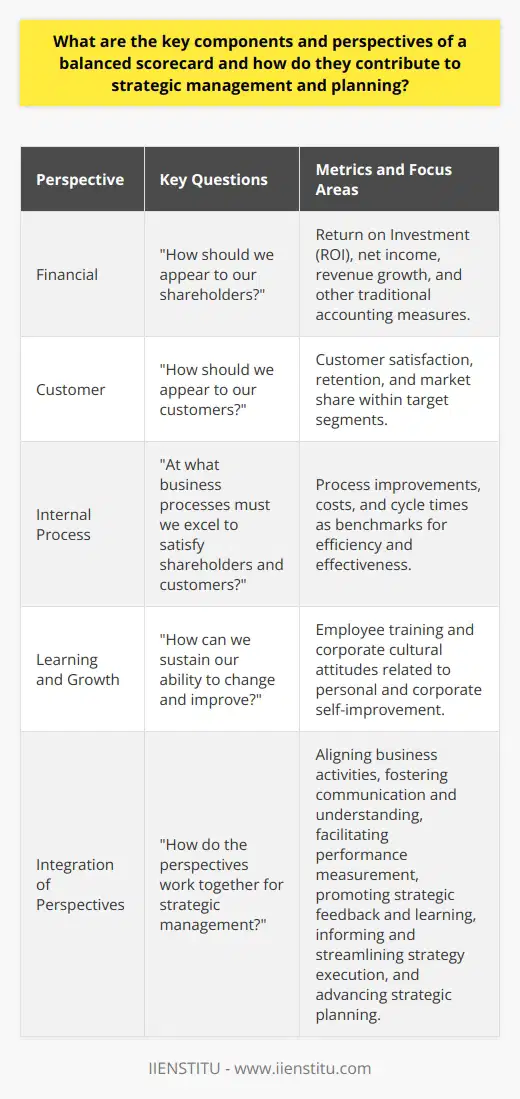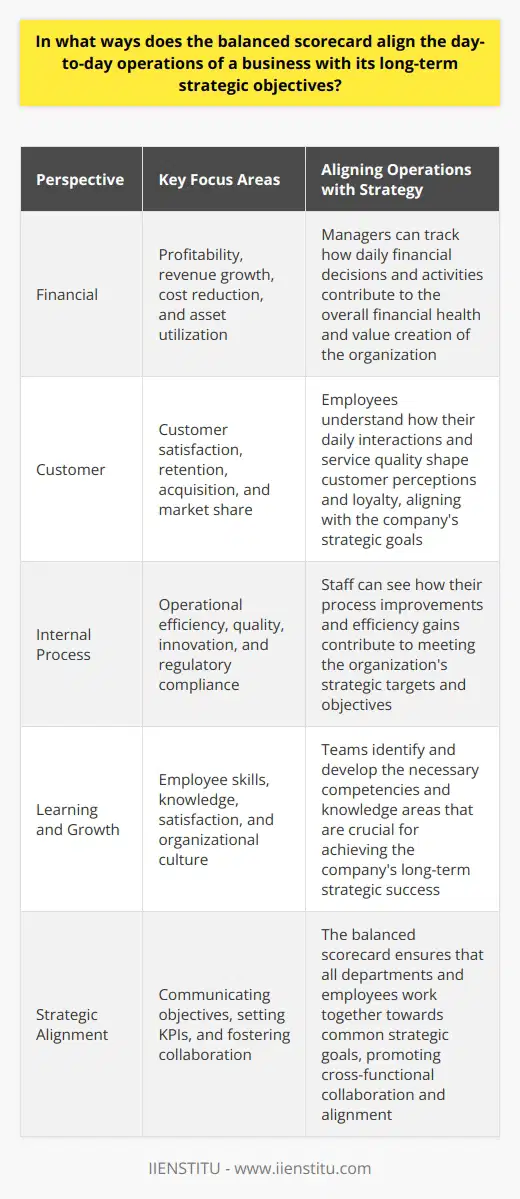
The Balanced Scorecard is an integrated strategic management and planning tool that allows organizations to translate their mission and vision into actionable strategies. Developed in the early 1990s by Dr. Robert S. Kaplan and Dr. David P. Norton, it offers a comprehensive framework for measuring organizational performance beyond traditional financial metrics.
The continuous evolution and validity of the Balanced Scorecard in today's complex business environment underscore its importance in aligning business activities to the vision and strategy of the company, improving internal and external communications, and monitoring organizational performance against strategic goals.
Understanding the Components of a Balanced Scorecard

Financial perspective
The financial perspective of the Balanced Scorecard focuses on the quantitative measures traditionally used by companies to track financial success. At its core, it emphasizes shareholder value and seeks to answer whether a company's strategy implementation is contributing to the bottom line improvement.
Real-world examples include Return on Investment (ROI), Earnings Before Interest and Taxes (EBIT), and Net Profit Margin. These metrics give a clear snapshot of financial performance and are essential for gauging the overall health of an organization.
Customer Perspective
In the customer perspective, the Balanced Scorecard assesses how well a company is performing from the customer's point of view. Organizations must determine the most relevant customer-focused metrics, such as Customer Satisfaction Scores, Net Promoter Scores, and Customer Retention Rates.
In practice, a company might survey customers to gauge satisfaction levels, strategically addressing areas of concern to maintain a competitive edge in the marketplace.
Internal Business Process Perspective
The internal business process perspective analyzes the efficiency and effectiveness of organizational operations. This concept revolves around identifying the critical internal processes that enable the achievement of the customer and financial objectives. Efficiency measures could encapsulate cycle time, unit cost, or productivity rates.
Collaborative İnsights For Actionable Solutions With World Café Method
Failure Modes And Effects Analysis Guide For Risk Management
To enhance internal processes, a firm may streamline operations or adopt new technologies to support better workflow management and drive performance improvements.
Learning and Growth Perspective
Lastly, the learning and growth perspective is the foundation that supports the other scorecard elements, focusing on the intangible drivers of future success. This includes employee training and development, organizational culture, and both internal and external knowledge sharing.
A prime example is a company investing in its problem solving course free for all staff, enhancing their skills and contributing to a culture of continuous improvement. This fosters an environment where innovation and growth thrive, essential for long-term success.
Advantages of Using Balanced Scorecard

Strategic alignment
Strategic alignment connects the dots between the organization's vision and day-to-day operations. The Balanced Scorecard is instrumental in translating lofty company goals into concrete strategies and actions. It acts as a compass guiding employees at every level towards the common strategic objectives, ensuring that the entire organization is moving in harmonious synchrony towards achieving its ambitions.
Balancing short-term and long-term objectives
Organizations often struggle to strike a balance between short-term pressures and long-term strategies. The Balanced Scorecard helps maintain this equilibrium by including metrics that reflect both performance types. For example, while quarterly profits might represent an immediate focus, measures like employee engagement and innovation rates plant the seeds for a prosperous future.
Enhancing company-wide communication and understanding
Clear communication and widespread understanding of strategic goals are critical for the seamless functioning of any business. By providing a clear framework and common language, the Balanced Scorecard facilitates an environment where objectives, strategies, and performance metrics are clearly understood across the entire organization. As a result, it can unify various departments and functions towards a cohesive strategy.
Implementation Challenges of Balanced Scorecard

Definition of implementation challenges
Implementing a Balanced Scorecard system can come with its set of challenges and hurdles that an organization must navigate. Adapting to a new way of performance measurement requires careful planning, continual adjustment, and a steadfast commitment from all levels of leadership.
Common obstacles in implementing Balanced Scorecard
Some of the most prevalent obstacles include resistance to change, which is a natural human inclination, a lack of understanding of the system's benefits, and insufficient allocation of resources. To illustrate, employees may be wary of a system that seems to add more complexity to their work, while management may not fully commit the necessary resources to train and support staff throughout the transition.
Solutions to overcome these challenges
Organizations can overcome such challenges by commencing with thorough education and training initiatives about the Balanced Scorecard system, providing transparent communication about the changes, and allocating a responsible team to support employees. A well-designed online certificate course in Balanced Scorecard methodology can be instrumental in enhancing understanding and promoting buy-in from staff.
Case Study: Balanced Scorecard in Action
Brief history of the company selected for the case study
Taking a pragmatic look at the Balanced Scorecard, let us consider a hypothetical technology firm, TechNovate, which has been struggling with aligning its different departments to drive cohesive growth.
Explanation of how Balanced Scorecard was implemented and used
TechNovate implemented the Balanced Scorecard to pivot from a product-centric to a customer-centric approach, measuring success beyond just financial gains. New customer-centric metrics were introduced, and internal processes were overhauled to focus more on customer service efficiency.
Review of the results and impacts of using Balanced Scorecard
Post-implementation, TechNovate reported a significant uplift in customer satisfaction scores and, interestingly, a direct impact on financial performance due to repeat business and referrals. Its internal processing times decreased, and employee morale boosted due to a clear understanding of how their work impacts the larger company goals.
Conclusion
In revisiting the Balanced Scorecard, both its significance and benefits remain evident. Its strength lies in providing a structured yet flexible approach to strategic management, encompassing multiple perspectives necessary for a comprehensive evaluation of performance. As businesses continue to navigate an ever-evolving landscape, the Balanced Scorecard stands out as a robust system that business leaders should consider integrating into their strategic planning. Observing the results from our case study, TechNovate, and many others, it's clear that when implemented correctly, the Balanced Scorecard can be an influential tool in charting a clear path to success.
References
- Kaplan, R. S., & Norton, D. P. (1992). The Balanced Scorecard - Measures That Drive Performance. Harvard Business Review.
- Niven, P. R. (2005). Balanced Scorecard Step-by-Step: Maximizing Performance and Maintaining Results. John Wiley & Sons.
- TechNovate Annual Corporate Reports (2019-2021).
Frequently Asked Questions
What are the key components and perspectives of a balanced scorecard and how do they contribute to strategic management and planning?
The Balanced Scorecard Explained
Organizations often struggle to translate strategy into action. The Balanced Scorecard (BSC) provides a framework for doing just that. It offers a more robust approach to strategic management. At its heart, the BSC reveals how a company's strategic objectives relate to one another. It balances a financial perspective with customer, internal process, and learning and growth perspectives.
The Four Perspectives of the Balanced Scorecard
Financial Perspective
This view focuses on the bottom line - financial health. It addresses the question: "How should we appear to our shareholders?" Here, traditional accounting measures like return on investment (ROI), net income, and revenue growth come into play.
Customer Perspective
Customers define business success. This angle asks: "How should we appear to our customers?" Metrics may include customer satisfaction, retention, and market share within target segments to gauge performance.
Internal Process Perspective
Efficiency and effectiveness rule this perspective. It queries: "At what business processes must we excel to satisfy shareholders and customers?" Process improvements, costs, and cycle times typically serve as benchmarks.
Learning and Growth Perspective
The BSC's final part focuses on organizational capacity. It considers: "How can we sustain our ability to change and improve?" Employee training and corporate cultural attitudes related to both personal and corporate self-improvement fall here.
Integrating the Perspectives for Strategic Management
The integration of these perspectives is where the BSC truly shines. It aligns various facets of business operation with the larger strategic vision. Metrics from each perspective come together to form a cohesive plan. Let's delve into this further.
Aligning Business Activities
Business activities align when metrics interlock. Silos break down. Interdepartmental collaboration rises. The message is clear: every part of the organization must move in harmony towards strategic goals.
Fostering Communication and Understanding
The BSC fosters communication. It builds understanding across the organization. Everyone from executives to front-line employees sees how their roles fit into the bigger picture. They understand the strategy.
Facilitating Performance Measurement
Performance measurement is essential. The BSC's approach allows for a balanced view. Companies measure financial performance while also considering customer satisfaction, internal processes, and capacity for innovation and growth.
Promoting Strategic Feedback and Learning
Strategic feedback loops are vital. They help identify when a strategy may not be performing as intended. Learning is continuous. Adjustments and decisions are evidence-based.
Informing and Streamlining Strategy Execution
Execution improves when informed by scorecard insights. Resources align with strategic priorities. Investments target areas identified by the BSC as needing improvement or capable of driving growth.
Advancing Strategic Planning
Strategic planning advances when the BSC is in play. It offers a forward-looking perspective. Companies can predict future performance by current metrics.
In Conclusion
The Balanced Scorecard turns strategic vision into actionable items. It breaks down complex strategies into understandable components. Each perspective offers a lens through which to view success. Together, they form a powerful tool for strategic planning and management.
With this approach, organizations can move beyond short-term financial metrics. They embrace a multidimensional view of success. The BSC encourages a continual process of evaluation, feedback, learning, and growth. It remains a driving force in robust strategic management practices.

How is the balanced scorecard applied in business performance measurement and what are its advantages over traditional accounting-based measures?
The Balanced Scorecard in Business Performance
The traditional accounting metrics offer a narrow view. They focus on financial outcomes. However, businesses operate in a complex environment. They need a more holistic approach. The Balanced Scorecard provides this broader perspective. It incorporates financial and non-financial measures.
Balanced Scorecard Basics
Robert S. Kaplan and David P. Norton developed the Balanced Scorecard. It emerged in the early 1990s. The scorecard balances different performance measures. It maps them onto four perspectives:
- Financial
- Customer
- Internal process
- Learning and growth
Each perspective includes objectives, measures, targets, and initiatives. Firms tailor these to their strategy.
Applying the Balanced Scorecard
Firms start with strategy. They then outline their long-term goals. Objectives link these goals to the four perspectives. They set up specific, measurable targets for each objective. The scorecard translates strategy into operational terms. It aligns various units and staff to the strategy. It also helps in strategy communication firm-wide.
Advantages Over Traditional Measures
Financial Measures Limitations
Traditional accounting focuses on financial performance. This focus is often too short-term. It overlooks other value drivers.
Holistic View
The scorecard offers a more comprehensive assessment. It integrates financial with operational indicators. This integration supports long-term value creation.
Improves Strategy Implementation
The scorecard outlines key drivers of success. It helps managers understand the strategy. They can make better decisions. It aligns day-to-day work with strategy.
Non-Financial Indicators
These indicators highlight intangibles. They cover employee skills and customer satisfaction. They lead to better future performance forecasts.
Promotes Organizational Learning
Feedback from the scorecard fosters learning. Firms can refine their strategy. They enhance their strategic capabilities over time. They adapt to changes.
Better Communication
The scorecard communicates strategy across the organization. Everyone understands his or her role in strategy execution. It fosters a shared understanding.
Conclusion
The Balanced Scorecard offers a robust framework. It blends diverse measures. In doing so, it provides a fuller picture of business performance. Its advantages over traditional metrics are clear. It drives better performance. It ensures all activities align with the overarching strategy. It also nurtures an environment of continuous improvement and learning.

In what ways does the balanced scorecard align the day-to-day operations of a business with its long-term strategic objectives?
Understanding the Balanced Scorecard
The balanced scorecard remains a pivotal tool in strategic management. It translates an organization's mission and vision into tangible objectives. It incorporates four perspectives: financial, customer, internal process, and learning and growth.
Aligning Operations with Strategy
Day-to-day alignment emerges as a core strength of the balanced scorecard. It ensures each task connects with higher strategic goals. The balanced scorecard fosters clear communication of objectives. It allows staff to see how their roles affect long-term achievements.
- Financial Perspective: It focuses on profitability and value creation. Managers can track how daily operations impact financial performance.
- Customer Perspective: This area addresses client satisfaction and market share growth. Employees understand how daily interactions form customer perceptions.
- Internal Process Perspective: This emphasizes operational effectiveness. Staff learns how their process efficiency meets strategic targets.
- Learning and Growth Perspective: It deals with the culture of continuous improvement. Teams identify skills and knowledge needed for strategic success.
Linking Metrics to Vision
The balanced scorecard uniquely bridges metrics with strategic vision. Each metric derives from broader strategic objectives. They act as signposts, guiding daily decision-making and priorities.
- Setting Performance Indicators: Every department has clear KPIs. These reflect on the organization's strategic thrust.
- Regular Feedback Loops: Employees receive real-time feedback on their progress. This reinforces the strategic direction.
Encouraging Strategic Participation
Through the balanced scorecard, staff engage with the strategy actively. They contribute their insights to strategic conversations. This participatory approach keeps the strategy relevant and dynamic.
- Empowering Teams: Workers across all levels take ownership of strategic goals. They help shape the path to achieving them.
- Enhancing Collaboration: Different departments work together. They align their actions toward united strategic objectives.
Fostering a Strategic Mindset
The balanced scorecard ingrains a strategic mindset in daily operations. It turns each task into a strategic action. Employees become strategic thinkers, not just task performers.
- Clarifying Objectives: The vision becomes practical and actionable. Each team member knows their role in the larger strategy.
- Promoting Agility: The organization adapts quickly to changes. The scorecard helps realign operations to new strategic priorities.
Conclusion
The balanced scorecard proves critical in marrying the operational with the strategic. It provides a framework that places every business activity within a strategic context. By doing so, it ensures that daily operations propel the business towards achieving its long-term aspirations.


